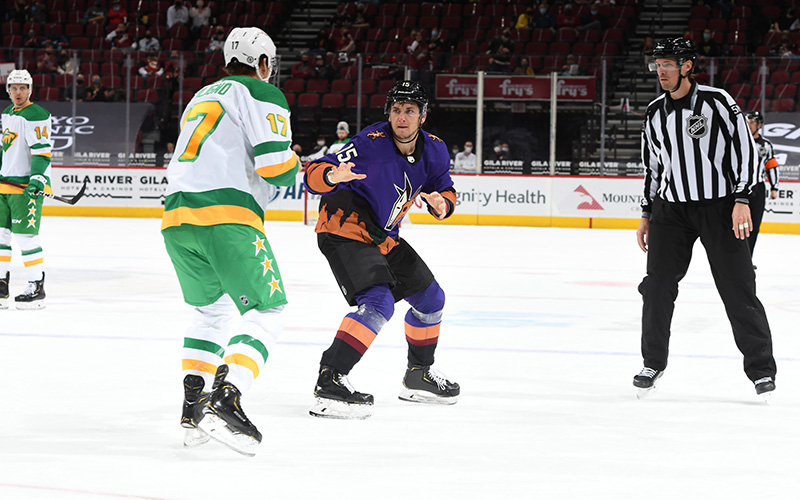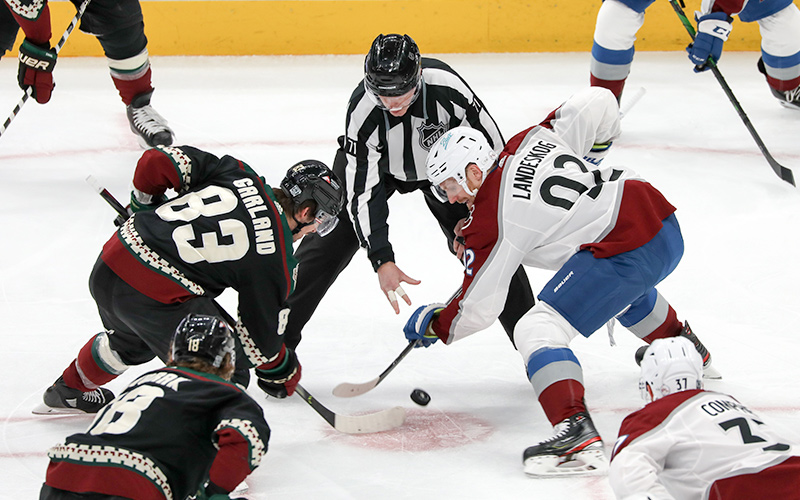
Arizona Coyotes coach Rick Tocchet said the decision by John Hayden (right) to drop the glove Saturday and take on Marcus Foligno of the Minnesota Wild “just shows his guts.” (Photo by Norm Hall/NHLI via Getty Images)
GLENDALE – One could easily have written the Arizona Coyotes off multiple times this season.
After a 5-1 blowout loss Friday and a 2-0 deficit through 20 minutes Saturday night against the Minnesota Wild at Gila River Arena, the Coyotes were in danger of chalking up another disappointing defeat on their home ice.
Turns out Coyotes forward John Hayden had other plans.
Moments after Minnesota forward Jordan Greenway sniped his team’s second goal, going top shelf past Darcy Kuemper following a neutral zone turnover, Hayden immediately jumped over the boards for an ensuing shift and dropped the gloves with a tough customer: Minnesota’s 6-foot-3, 223-pound wing Marcus Foligno.
“That was big,” Coyotes coach Rick Tocchet said. “Foligno is a huge guy, so it’s not like he’s fighting a slouch. For (Hayden) to hang in there with him just shows his guts.”
Hayden’s first fight of the season led to another gutsy effort, this one from his team.
The Coyotes erupted for five unanswered goals in the second and third periods to secure a 5-2 victory over the Wild in front of a pandemic-limited sellout crowd of 3,141 fans.
It was Arizona’s fifth win of the season when trailing after the first period, tied for second in the NHL with the Florida Panthers, Tampa Bay Lightning and Pittsburgh Penguins. Only Winnipeg, with six wins after trailing at the end of the first period, led Arizona through Sunday’s games.
Coyotes forward Lawson Crouse kickstarted the comeback 85 seconds into the second period with his first goal in 23 games. He last scored in a regular-season contest March 4, 2020 against the Vancouver Canucks.
You love to see it. ? pic.twitter.com/yh9Nk8c2pp
— Arizona Coyotes (@ArizonaCoyotes) March 7, 2021
“I think I felt 1,000 pounds lighter there,” said Crouse, who buried a rebound in the blue paint to get rewarded, a testament to his teammates’ no-quit mentality. “We just wanted to come out and attack, attack, attack, and we did. At that point, we just had to lock it in.”
Crouse, who skated with new linemates Conor Garland and Nick Schmaltz, acknowledged the team’s lack of competitive energy out of the gate when the Coyotes put just seven shots on goal in the first period, compared to Minnesota’s 14.
“We haven’t been very happy with our starts, and that’s been an issue of late, so we had to buckle down and we knew it,” Crouse said. “We weren’t happy, but after that, we came out and played a great hockey game.”
The Coyotes won despite not scoring in the opening frame for a 10th consecutive game. They’ve allowed 13 goals in the first period since Garland scored 21 seconds into a 5-4 overtime loss to the St. Louis Blues on Feb. 13.
From late rushes in pursuit of forechecking defenders to sleepy breakdowns in the defensive zone, playing with a high level of intensity and focus from the initial puck drop has been a noticeable missing element.
Despite the slow starts, the Coyotes have been able to reflect and recharge during first intermissions and then put on the gas. Their 28 second-period goals rank seventh best among the NHL’s 31 teams. Their plus-13 goal differential in the middle frame also puts them in the top-five in the league.
While the Coyotes have been slow starters, they’ve shown a knack for finishing strong with a 6-1-0 record when leading after 40 minutes, showcasing their hard-nosed determination in the closing minutes of regulation.
The group has stayed locked in defensively and executed smart plays in the neutral zone and Tocchet has shortened his bench for clean and concise shifts until the final whistle.
It’s all part of the team’s recipe for comebacks.
“Credit to our group for sticking with it and having that mindset that we’re not going to quit, we’re not going to roll over, and we’re going to play until the end,” Crouse said.
Coyotes forward Tyler Pitlick helped shape the bounce-back rally against the Wild with his fourth and fifth goals of the year on a team season-high seven shots. Tocchet said Pitlick has been one of the team’s hardest workers lately, earning an elevated role within the top-six alongside skilled playmakers Clayton Keller and Christian Dvorak.
“We dug deep and we kept going,” said Pitlick, who scored twice for his fourth career multi-goal game and first since Dec. 31, 2017. “We kept going north and just doing the simple things. When you do that, then the plays start to come. When you play the right way, good things happen.”
Arizona’s resiliency stems from coming up with big plays in big moments, which Tocchet has preached throughout the first two months of the season.
In their season-opener against the San Jose Sharks, the Coyotes salvaged a critical point from a two-goal, third-period deficit when Phil Kessel swatted the puck out of mid-air on the doorstep for a fortuitous goal with 3.2 seconds left in regulation.
During their seven-game playoff-like series with the Blues, Arizona bounced back two times, including a Keller game-tying goal with seven-tenths of a second left on the clock en route to stealing three of four from St. Louis at the Blues’ Enterprise Center.
THIS IS WHY YOU PLAY ALL 60 MINUTES. pic.twitter.com/QrwQB7awSV
— Arizona Coyotes (@ArizonaCoyotes) February 9, 2021
Tocchet’s squad shocked many with consecutive, come-from-behind wins against the Anaheim Ducks on home ice, becoming the eighth team in NHL history to win back-to-back games when trailing by three-goal margins.
“It’s something we’ve gotten better at over the last few years,” Tocchet said. “We’ve won some games coming from behind… That’s something you can hang your hat on when you can have that resiliency. Now, it’s a matter of starting the game, managing the game early on and pushing the pace.”
Tocchet’s point is valid. The Coyotes need a first-period shot of adrenaline. They have just nine goals in the opening period, second-to-last in the league ahead of only the Dallas Stars.
Tocchet and his players know their ability to mount a comeback isn’t a sustainable winning formula in order to maintain their ground within the tight race of the Honda West Division. With an 11-10-3 record, the Coyotes currently sit two points back of the fourth-place Wild, who have two games in hand due to earlier scheduling readjustments from COVID-19 complications.
“You don’t stop believing, but we can’t get a steady dose of this,” Tocchet said. “The odds will go against us eventually. It’s great that we come back, but we’ve got to be careful.”
After playing 17 of their first 24 games at Gila River Arena, the Coyotes are set for a two-week, seven-game trek through Colorado, Minnesota and Anaheim. The limits of the Coyotes’ resiliency will be tested in what could potentially be a make-or-break road trip if the Coyotes hope to reach the 2021 Stanley Cup playoffs.
“We just have to play (like) those second or third period periods right from the puck drop. If we can do that, look out,” Crouse said. “We got a tough road trip coming up. It’s a great way to finish this homestand with a win. We’ve just got to play that same way with that same intensity and … compete.”

